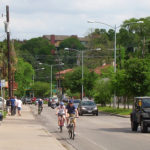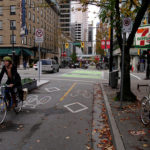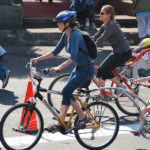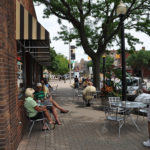Posts in the 'Road Safety' category
Welcome to “Research Recap,” our series highlighting recent reports, studies and other findings in sustainable transportation policy and practice, in case you missed it. Water Shortages One billion city dwellers will suffer from water shortages in 2050, predicts a scientist ...

Welcome to “Research Recap,” our series highlighting recent reports, studies and other findings in sustainable transportation policy and practice, in case you missed it. Bike Helmet Benefits The debate on the safety benefits of bike helmets rolls on with new ...

The City of Denton in Texas approved a traffic safety ordinance to assert the rights of the road for cyclists and other vulnerable road users. The “Vulnerable Road Users” or “Safe Passage” ordinance requires cars and light trucks to allow a ...

U.S. Transportation Secretary Ray LaHood announced a 3 percent decrease in road fatalities between 2009 and 2010, which still adds up to 32,788 deaths. According to LaHood, last year’s traffic fatalities fell to the lowest levels since 1949, despite a 0.7 percent increase ...

Heze City police in the Shandong province of China recently aired accident footage from traffic cameras as a public service announcement to raise awareness for road safety. The 12-minute video of gruesome and violent images is further proof of the ...

Originally posted on EMBARQ.org: A new online competition, Active Cities, Healthy Cities, was launched today to raise awareness of cities in Latin America and the Caribbean dedicated to sustainable transport, the environment, and creating a healthy lifestyle for their citizens. ...

Welcome to “Research Recap,” our series highlighting recent reports, studies and other findings in sustainable transportation policy and practice, in case you missed it. Roadblocks for Electric Vehicle Adoption Deloitte, the international accounting and consulting firm, recently published a study ...

There’s a few weeks left to vote for the Philips Livable Cities Award, a global initiative launched in May 2010 designed to “generate practical, achievable ideas for improving the health and well-being of people living in cities.” Philips asked individuals and ...

The historic and ornate city of Arequipa is the economic and cultural hub of Southern Peru. But crowded streets, poor air quality and a disordered array of buses characterize mobility in this Andean city, the second largest in the country. ...

It is crucial to develop a robust, simple and meaningful set of indicators to measure the impact of transport policy on public health in order to achieve any real change in the status quo, according to Dr. Carlos Dora of ...

This interview is part of a series with sustainable transportation advocates, planners, engineers, journalists, sociologists, and other experts working to shed light on best practices and solutions from across the globe. We welcome your suggestions for future Q&As. “Adding highway ...

About half of the world now lives in cities, and this figure is expected to grow to 70 percent by 2050, with most urban growth projected to occur in developing countries. As people move to cities at this unprecedented pace ...

The U.S. Environmental Protection Agency (EPA) annually sponsors the National Smart Growth Achievement Awards as part of its Partnership for Sustainable Communities with the U.S. Department of Housing and Urban Development (HUD) and the U.S. Department of Transportation (DOT). The smart ...

Generally, in the United States larger grocery store chains supply a variety of fresh food at lower costs, while independent grocers, bodegas and smaller stores have less selection and higher operating costs and prices. Such stores tend to have a ...

U.S. Secretary of Transportation, Ray LaHood recently announced the Walk Friendly Communities (WFC) program, an initiative that “will recognize communities that are working to improve a wide range of conditions related to walking, including safety, mobility, access and comfort.” The initiative ...

Page 30 of 34« First...1020...293031...Last »























